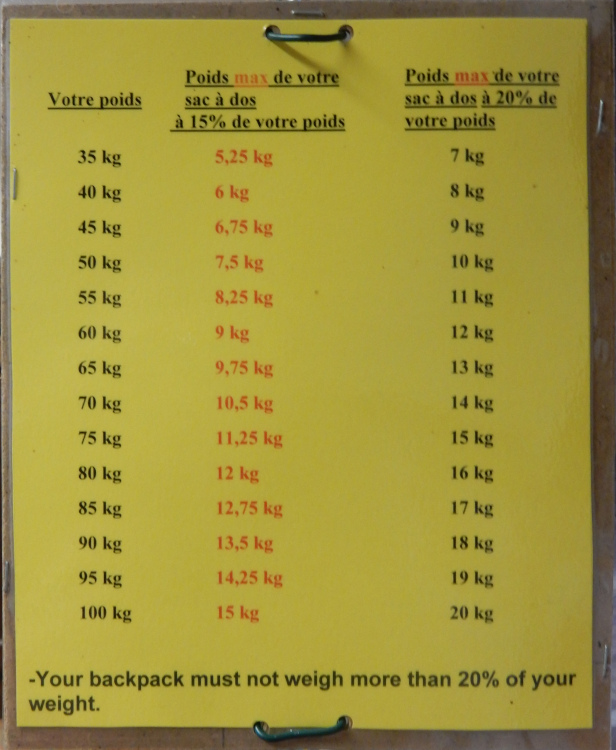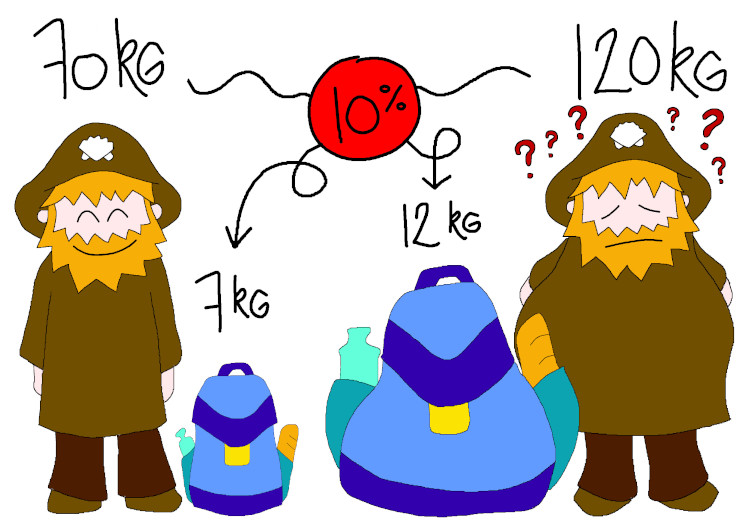Who has never heard of the famous “10% rule”? It’s everywhere, pretty hard to escape it… Yet as it is, this rule is wrong! Yep yep, you read it right. Wrong! What? Have people been lying to you? Is there a secret conspiracy targeting pilgrims’ backs? Well, not exactly…
Let me explain why the “10% rule” is a myth… and what to do to use it properly!
What is the 10% rule?
The 10% rule is wrong… and it’s logical it is!
The detail that makes all the difference
What now?
A personal suggestion

What is the 10% rule?
When it comes to know how much a backpack should weigh, BINGO! The 10% rule appears. I don’t know where this “rule” comes from, but what’s certain is, we hear about it everywhere. Between pilgrims on the Camino, in books, on social medias… impossible to cut it!
The formula is simple: a backpack must weigh a maximum of 10% of the weight of the person who carries it. Take the weight of a person, multiply it by 10, take the result and divide by 100: the result is the maximum weight that person’s backpack should be. Said in math language: (Kgx10):100= max weight of the bag. Works with pounds all the same! Since a picture weighs 1000 words (haha!), I’ll spare you more blah blah and math to show you directly what it looks like:

Your sharp eye will have noticed that the photo shows calculations made for 15 and 20% of someone’s weight. The formula and its principle are the same, even though pilgrims usually do calculations with 10% (well… it is easier!). In any case, we find ourselves with:
- on the left, the person’s weight
- in the middle and on the right, the maximum weight that person’s bag should be, for 15 and 20% of that person’s weight
- as an example: a person who weighs 40kg/88lb can carry a maximum of 6kg/13lb (rule for 15% of the weight) or 8kg/17.5lb (rule for 20% of the weight). Or 4kg/8.8 max, if we use 10% of the weight!
Well now, in theory… it should click! Otherwise, no problem, keep reading, I’ll explain 😉
The 10% rule is wrong… and it’s logical it is!
Let’s illustrate the problem with an example. Let’s imagine someone completely at random*: James. For his 1st Camino, James weighs 70kg/155lb (dripping wet). Following the advice he received to the letter (on Facebook or elsewhere, we can’t say), James is forced to limit the weight of his bag to 7kg/15.5lb. “10% rule” rules! It’s really though, but James succeeds and arrives radiant in Santiago. Then he goes back home. And then bummer! Depressed not to be on the Camino anymore, James comforts himself with sweets and drowns himself into his desk job. James gains 50kg/110lb before he can free some time up to leave again for another Camino.
He now weights 120kg/265lb, James begins his preparations and O Joy! He realizes after some quick calculations that this time, he can pack a 12kg/26.5lb bag! “10% rule” rules! With pleasure, James allows himself to take a toothbrush with a handle and a second underwear. And a few other things. A long time before arriving in Santiago (in fact, from the very 1st day), Jacques has a hard time carrying his backpack… He racks his brain but he doesn’t get it… His bag is exactly 10% of his weight! What’s going on???

Drawing: Marion for Santiago in Love – CC BY-S1-NC
And you? Could you explain to James what went wrong this second time? 😉
Maybe you’re like me and math isn’t your thing. Or maybe riddles of logic kill your neurons. Thankfully in this case, we don’t need to be a black belt in chess or Rubik’s cube to figure it out! Calculations are good, problems rise when we apply it in real life. As it’s stated, the 10% rule implies that the heavier you are, the more weight you can carry. And we can see it clearly with the chart on the picture above: the heavier you are, the heavier your backpack becomes.
And here’s the rub, because this result is completely counter-productive!
The detail that makes all the difference
I said right above that calculations were good but their practical applications were bad. Okay. Something else’s wrong too: the numbers we use. As it’s stated, 10% rule is based on a person’s weight. If we want to use this formula as a reference, we should base it on the person’s health weight for it to be effective. Health, or fit, or ideal weight. Can you see the difference it makes to use this new number?
In the previous example, James’ weight was 70kg/155lb on his 1st Camino. This was his health weight. For his 2nd Camino, James has not changed his health weight: it’s still 70kg/155lb. However he is now 50kg/110lb overweight, which should not count when calculating the weight of his pack! Because to be overweight doesn’t mean you can carry more weight. It would rather mean that, since you already carry extra weight on you, you should carry less in your bag! Eventually and according to the adjusted 10% rule, James should have left with a 7kg/15.5lb bag!

Drawing: Marion for Santiago in Love – CC BY-SA-NC
The 10% rule should therefore be applied differently. We should stop using people’s weight, but use their health weight. It can be found with diet-specific calculations (BMI, ideal weight, etc.) or with charts available in books or on the Internet. Health weight varies greatly from one person to the next and depends on height and stature (and other stuffs). It is generally between 40 and 80 kg/88-175lb for women and between 50 and 90 kg/ 110-200lb for men. If we apply the adjusted 10% rule, results gives us backpacks weighing between 4 and 8kg /9 and 17.5lb for women; between 5 and 9kg/11 and 20lb for men… We are very far from the figures suggested on the chart of the picture!
Overall conclusion to remember: used correctly, the 10% rule shows us that a bag should weigh less than 10kg/20lb.
What now?
After all we’ve talked about together, you can easily guess! If you want to use the 10% rule, use it correctly. Make sure you find your health weight first… and use it for your calculations!
Also keep in mind that this 10% rule is purely informative AND rough. It’s used to get an idea of the weight of the backpack, but it’s not a goal to reach at all cost. If you’re below it, well done, that’s great! If you’re above, that’s probably ok too. Humans are able to carry impressive loads! But since not everyone is a Sherpa, just make sure you reach a weight you can carry without harm. Based on the conclusions we just drew above, think that below 10kg/20lb, your bag is pretty good!
A personal suggestion…
To me, using the 10% rule is not worth it (even readjusted)… What, wait? How can I say that after a whole post on the subject?!? Well… let me explain 😉
- First because obviously, almost nobody uses this formula correctly … Although not you anymore, congrats!
- Second, because before we can use it correctly, we have to go through complicated calculations that give arbitrary results anyways. Health weight varies a lot from one person to another and it depends on a whole bunch of things. Plus, health weight is not a precise number, but moves within a range!
- Also, depending who’s talking about it, the reference changes. People use 10%, 15% or 20%. Mostly 10%, just because it’s easier to do math with. There’s nothing scientific about it.
- Even when used properly from start to finish, it gives us unreliable results. What people can carry also varies a lot from one person to another and it also depends a whole bunch of things.
- It also makes people feel guilty and stressed about their pack’s weight…
- Last but not least, because to me, the less math, the better 😉
Anyways, one thing is certain under all circumstances: lighter bags are easier and more comfortable to carry! Why bother with the 10% rule? I suggest instead a new directive: “the lighter the better!” Less than 10kg/20lb is good, but let’s always try to make our packs as light as possible. It takes time, thoughts, trials, (re)adjustments… and it’s a never-ending process! Here’s some place to start…

Drawing: Marion for Santiago in Love – CC BY-SA-NC
Happy preps and good luck, may your backpack be as light as can be!
*The character and situations portrayed in this examples are fictitious. Identification with actual persons who would feel targeted was not intended and shouldn’t be inferred 😉





I found the opposite problem with 10% rule. As a small woman it was almost impossible to get my pack small enough. I packed only 2 sets of clothes (wear and spare) first aid and sleeping bag liner. Added to the weight of the bag and 1kg allowance for water I was already struggling to get below the 10%. I considered leaving my one fleece but I’m glad I did not because sometimes it was really cold (also if you are small maybe the extra insulation is more important). Also, once I arrived i was buying food to carry so i could eat on the road – verduras in glass jars add up. I brought only a soap bar but ended up buying shampoo here because the heat and moisture was not kind to my hair. My pack was small and I never had any problems but stressing about strictly 10% did not help me. ¹
Thanks for sharing your experience Amy 🙂 You’re right, it does make problems this way as well… Sorry your stressed about those 10%, but it seems you made the right choices eventually and that you had a nice Camino anyways. That’s what matters in the end!
That pack size is a myth too as
far as I’m concerned. I carry a 46L Ospry Kyte that fits like a glove. I carry less than 6kg. The bag gives me space for food and digging around inside without having to empty it everytime I want something.
thank you i am referencing this in my coursework
This was a great read and I do hope many more come across to read this. I was looking up how heavy my backpack should be for work and this made me rethink how to go about it. Thanks for sharing with us!
Thank you for your nice comment Keisha 🙂 I’m happy the post helped you! Of course, you can absolutely share it and spread its message too 😉 Ultreïa!